-
Talking about Matthew Chamber’s ceramic sculptures in FT How to Spend It, actor James Nesbitt, said: “I look at this piece with real wonder and hope. There is an endless, integral beauty to it that I find very moving. It’s extraordinary. Almost wondrous.”
- James Nesbitt, actor FT How to Spend it May 29th 2020
This is a typical response from clients who, like James, have bought Matthew Chamber’s sculptures from Cavaliero Finn over the years. We love to see the reaction of people seeing Matthew’s work for the first time. You can physically see their mouths drop, while they wrack their brains, trying to work out how on earth his circular sculptures are made. Aside from their undeniable beauty, they are technically astounding and totally unique, which is why we have worked with Matthew for over 15 years.
Good at acting, “terrible at art” - James Nesbitt is honing his craft (collection) via a leading gallerist. Article by Charlotte Abrahams in this weekend’s FT How to Spend It.
As part of our ongoing series of artist features, we managed to drag Matthew away from his garage, where he has set up a temporary studio during the lockdown, to talk to him about his work and how he feels about clients who collect his work.
Cavaliero Finn: You have clients who have collected your work for many years, what is it like to have your work collected?
Matthew Chambers: It always feels great to have somebody fall in love with what I’ve made, so much so that they’d like to own and live with it every day. Indeed it is an investment in who you are – it’s a confidence and a trust that’s given to you, and it’s never taken for granted. This faith, in turn, helps motivation, and you strive to get ever better and stronger because of it, somehow helping to repay the trust the collector has given you. When you get a repeat collector over many years it gives you the belief that this is happening, or at least that their love for what you do is still as strong as it was at the beginning.
Earth Red Slow Twist Sculpture, Stoneware circular sculpture, 38cm diam, 2020
CF: Recently you have been exploring new forms. Tell us a little about the work you have been creating during the lockdown?
MC: I was planning for 2019 to be the year to take some time out to experiment and hopefully create something new. Whilst ideas began, it didn’t go far as I would have liked as commissions for my existing work got in the way. But when the current lockdown began in March everything else suddenly stopped, and I had to leave the studio to stay home full time and to look after my kids.
I decided to make a temporary studio in the garage to enable a little bit of continuation whenever I found some time to do so. But like most of us, I felt a general sense of hopelessness when it all kicked off, and I didn’t feel like carrying on with my normal work as life had suddenly become anything but.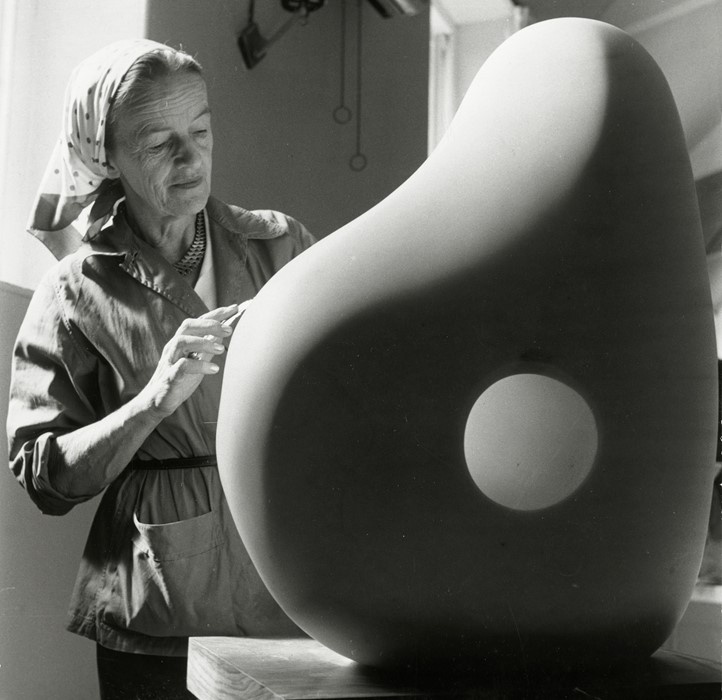
Barbara Hepworth at Trewyn Studio, 1961 Photograph by Rosemary Mathews, Courtesy Bowness, Hepworth Estate
MC: I decided then it was again time to play. I began by looking at Barbara Hepworth – my all-time greatest inspiration – using some of her formal elements to build upon, whilst trying to do something new of my own. Developments have steadily continued from one to the next in the weeks since lockdown, and there now seems to be a particular focus coming into play. Ideas are still in no way resolved and it still the beginning, but I feel I might now be in a place where I will continue development into whatever kind of normal we get after all this is over.
I intend to continue developing the work I’m known for as I still very much love (and currently miss) the strong repetitive processes involved.
CF: What process is involved?
MC: The processes in the experiments are in a way quite different – still very much born from the wheel, but moving much further into a focus on hand-building around the wheel-thrown elements that make up the form. I’m trying to focus less on just the circle alone, whilst trying to maintain a certain flow and rhythm that I try to effect in all my work – separate elements that speak to each other through their pattern and form.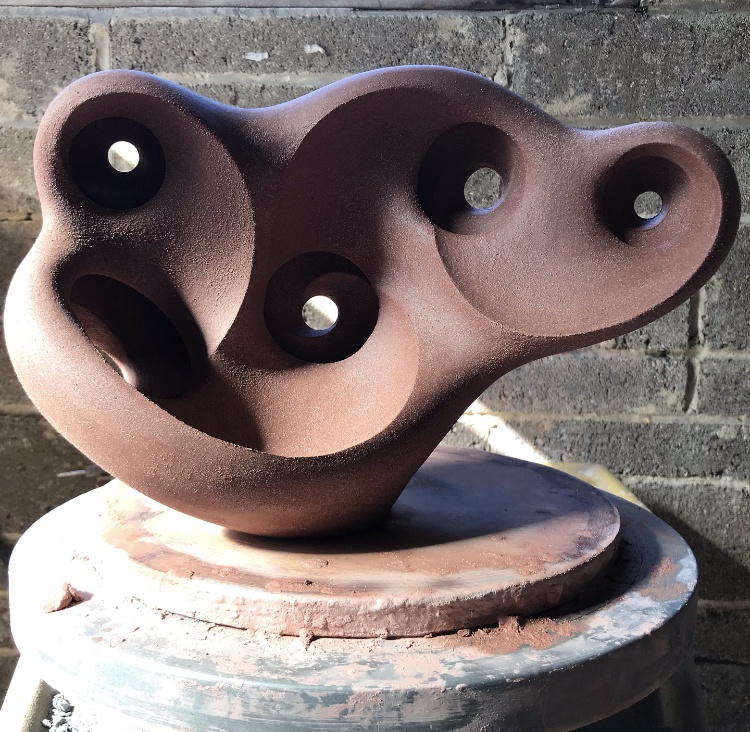
The latest of Matthew Chambers experimentational forms created during lockdown
CF: How did you become a ceramicist?
MC: It was totally by accident. I left school at 16 and got a job as a trainee chef in a local pub. After a couple of years in I realised this just wasn’t for me, and I luckily stumbled upon an apprenticeship with the potter Philip Wood who happened to live in the village where I grew up. After starting there it didn’t take long to get a grasp and get addicted, and the pull of clay soon drew me in and the passion grew
CF: Your work with Philip Wood was making very functional pieces, why did you decide to stop making functional ceramics?
MC: After my six-year apprenticeship with Philip, I went into full-time education, gaining a BA (Hons) 1st Class in ceramics from BSUC, Bath, followed by an MA in Ceramics and Glass from the Royal College of Art. It was in my first year of education that I discovered my passion in form alone, and I instinctively followed this. It was not long after this that the need to create work with a specific function left me. It has continued this way ever since, but still the skill and technique I learnt in repeat throwing for function is still very much an important and integral part of everything I do today.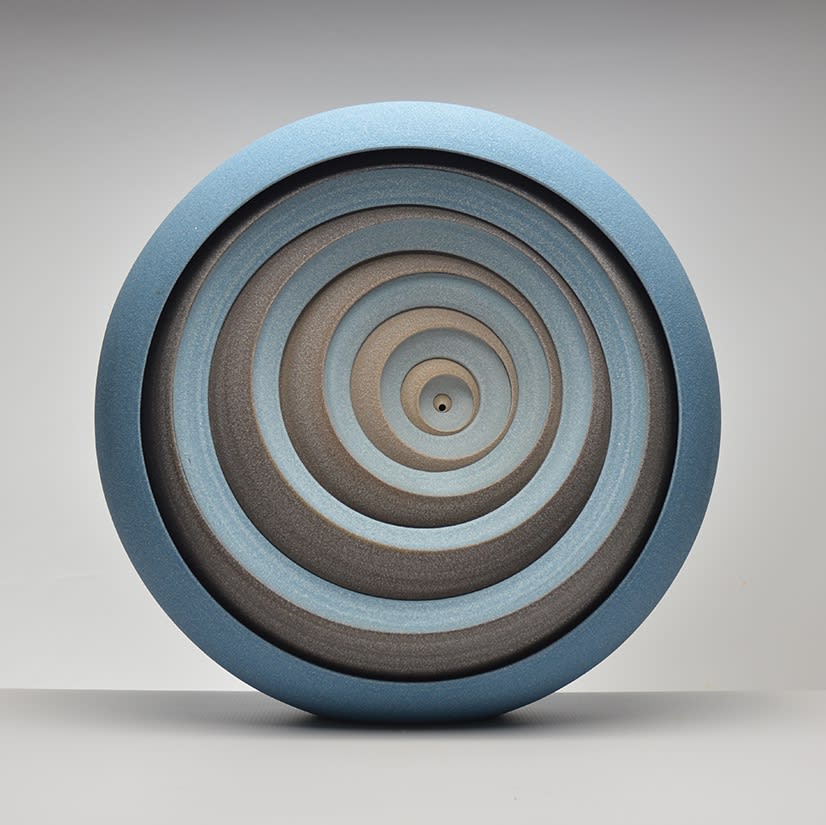 Blue and Grey Layered Twist Sculpture, Stoneware circular sculpture, 38cm diam., 2020
Blue and Grey Layered Twist Sculpture, Stoneware circular sculpture, 38cm diam., 2020CF: Have you ever thought about creating ceramic work away from the wheel?
MC: No. Since my apprenticeship began in 1993 the wheel has always been the most essential tool for everything I do and have ever done, and it’s the process where I am most happy and feel most at home. Although there’s been hand-building involved in much of my work and even more so in my current experiments, the wheel remains the starting point and the essential tool for everything that comes after.
CF: You once said that “It is a true love of the making process that drives the creation of my sculptures” can you elaborate on this?
MC: Everything in my work is about the process. I use colour within the clay instead of glaze – much simpler to control and less time consuming, and there’s no fancy or unusual firings to finish things off. It’s for formal reasons why I work this way of course, but it also helps to keep everything simple and aim my focus toward the making. It’s what I love most, and perhaps what others might also appreciate about the work. I think I’d probably be happy making 24hrs a day if I had nothing else in life or didn’t need to sleep! However repetitive it might get or physically exhausted I may be, I never ever get bored of it.
With clay, it feels impossible to ever fully master the material as the learning is continuous. The 10,000 hours rule seems not enough time at all, in fact, life seems not long enough however old you may live or however much time you devote to it. There always seems to be more to learn, even in the very minor details of a very repetitive process and this is what I am drawn into. Things can always be refined and made better which in turn brings new discoveries, and from these discoveries, new ideas are born.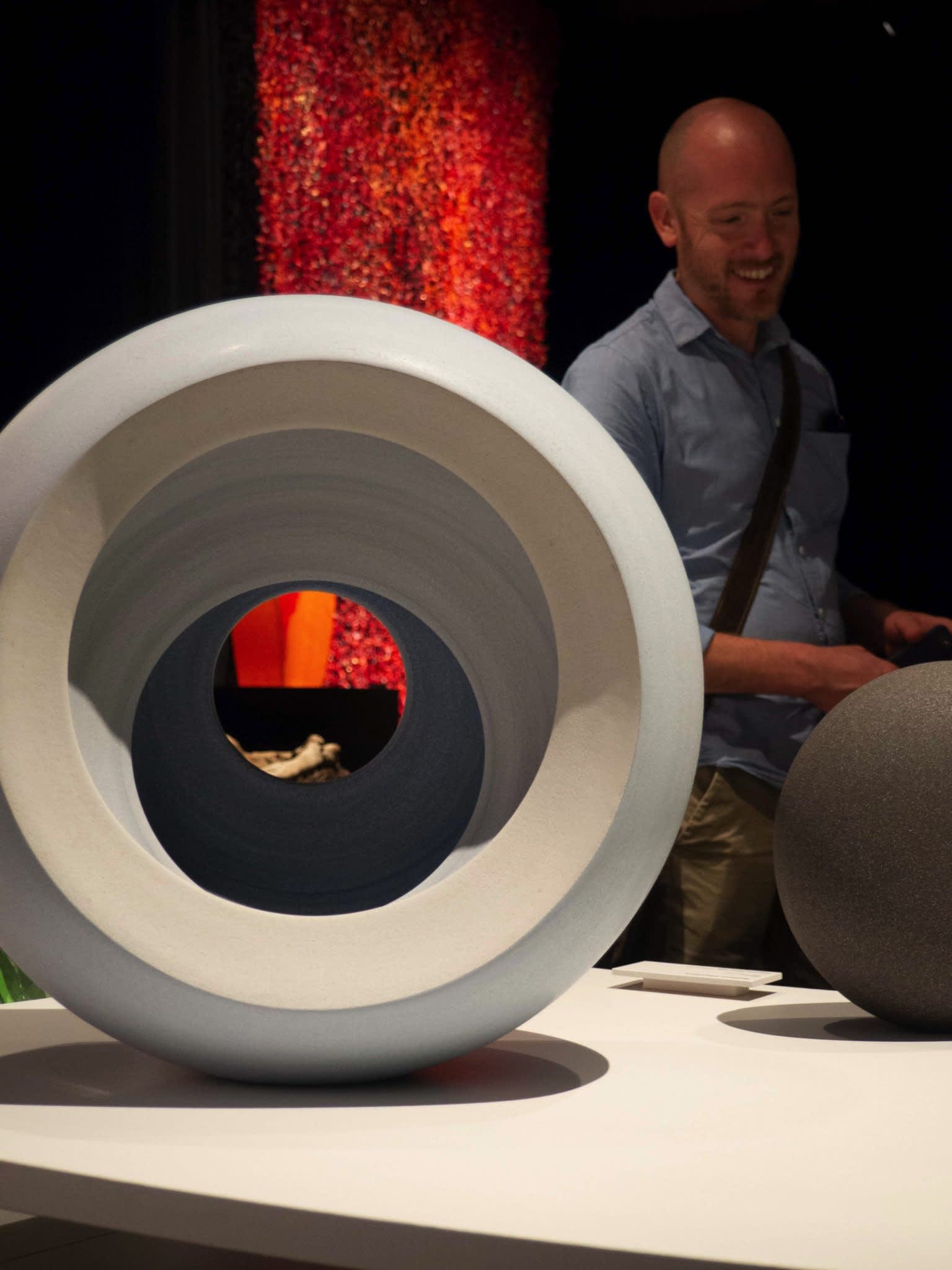
Matthew Chambers with this work in Venice at Homo Faber in 2018
CF: What does art mean to you?
MC: Art for me is something that carries an expression of strong emotion and doing so just from its being. Music has always been my greatest love for its ability to do this so instantly and naturally, and the forms of visual art I appreciate most are the works which aim to run in parallel to this and carry an instant power. Whether it’s possible for my own works to do this I’m not sure, but I’ve been moved by art like this many times and it’s a continuous aim to one day create something that will hold this kind of emotion for other people.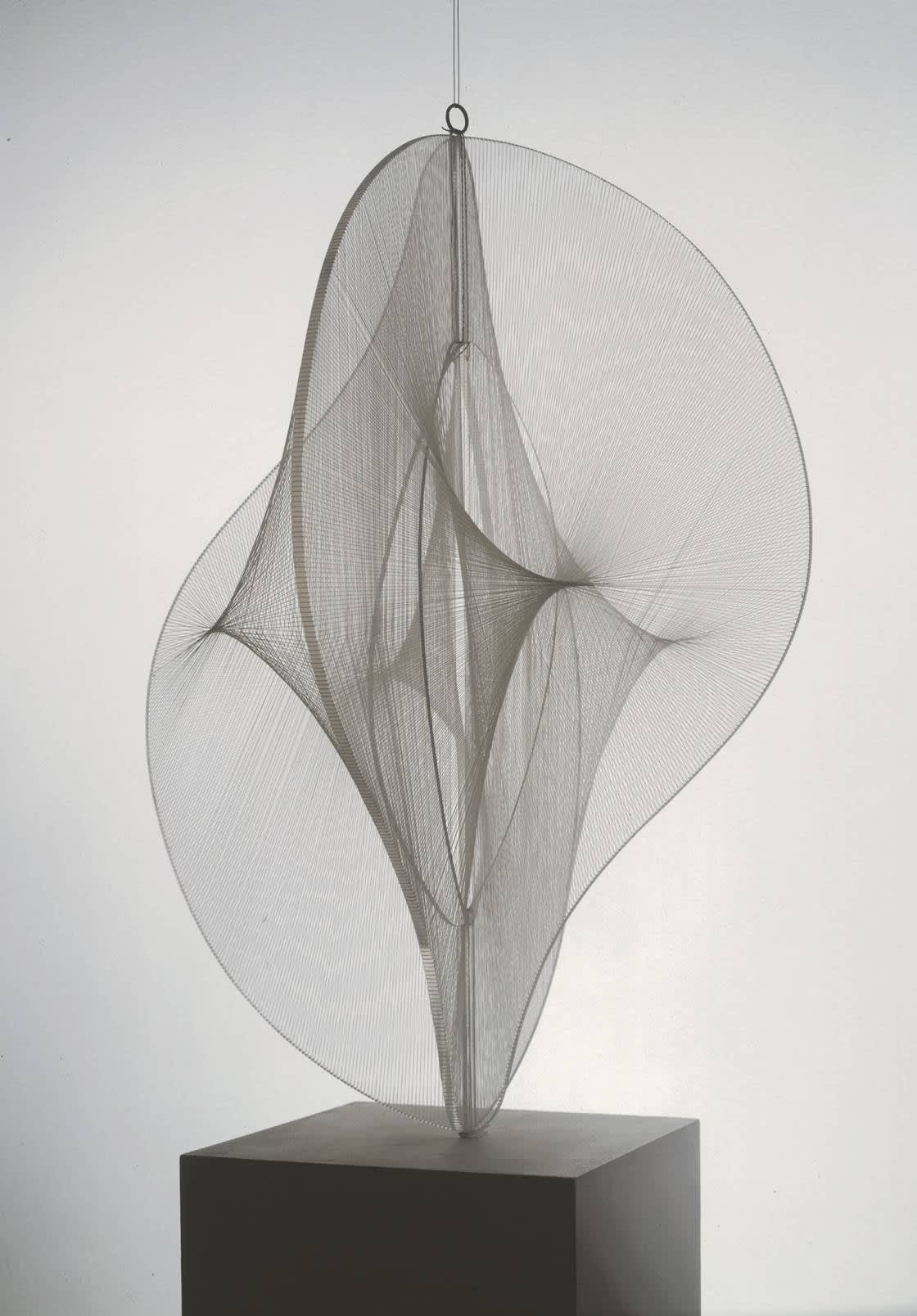
Naum Gabo, Linear Construction No 2, 1970-1 Tate. The Work of Naum Gabo © Nina & Graham Williams / Tate, 2018
CF: Which artists inspire you?
MC: Many, but to narrow it down I’ve long been inspired by artists working around the mid 20th century, especially the St Ives school. Barbara Hepworth of course and as mentioned, but I’m also greatly drawn to the relief work of her once husband Ben Nicholson, and the constructivist sculptor Naum Gabo who spent much time in St Ives sharing ideas and working alongside. This group seems to have started a new language in abstract art which has influenced many other artists over time, and which continue to do so today. I’m not sure what the art world would look like today without this influence but I’m sure it would be very different, and my work certainly would be.
CF: What do you hope to communicate with your work?
MC: Simply to convey a little bit of beauty. I sometimes feel guilty or insecure that there may be no bigger themes in my work which may contribute to carry deep meaning or make a weighty artist statement. There are hidden themes in there for sure, but these perhaps work subliminally and under the surface. I don’t feel an urge to make them a driving force because to put it simply, they’re not. Art can have strength through its simplicity, where beauty on the surface is enough. However simple it might seem. We all need a bit of beauty in our lives, especially in current times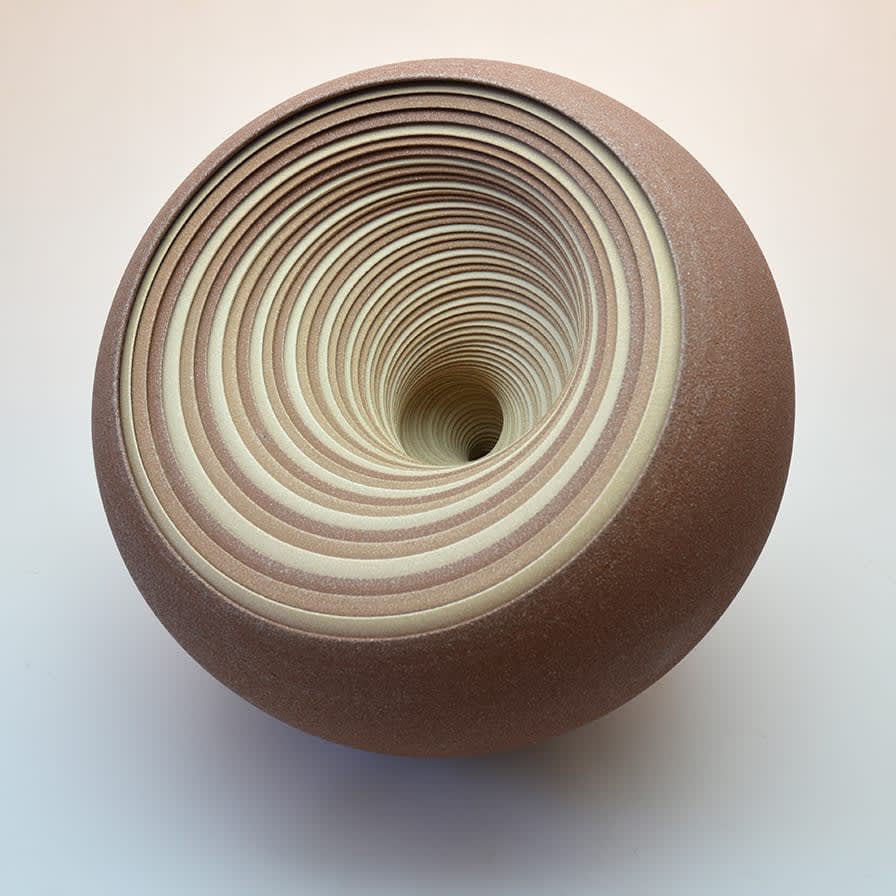
Red Fade Spiral – Stoneware circular sculpture, 27cm diam.
There are 69 individual wheel-thrown sections inside arranged in groups of 3, and each one has a subtle change in colour tone as the pattern slowly fades into a cream at the centre.
This piece was acquired by The Victoria and Albert Museum at Collect 2019 by the kind donation of Christopher Gorman-Evans.MC: Your work is in the permanent collection of several museums including, the Victoria and Albert Museum in London, the Fitzwilliam Museum in Cambridge, the Musee Ariana in Geneva and the Musee National de Ceramique de Sevres in Paris? How does this make you feel?
Amazing, and for me, the ultimate accolade possible is to be collected by a museum. I feel incredibly lucky to have had my work accepted on such a level and amongst such great and important works as there are in all of these institutions.
CF: Thank you for talking to us Matt.See Matthew's work here